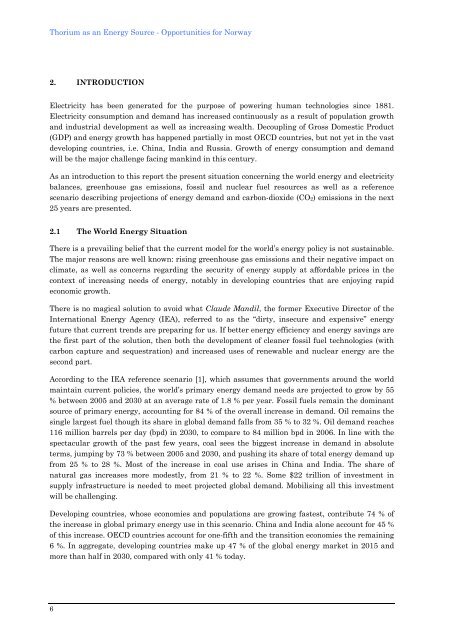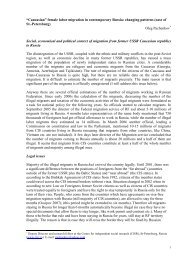THORIUM AS AN ENERGY SOURCE - Opportunities for Norway ...
THORIUM AS AN ENERGY SOURCE - Opportunities for Norway ...
THORIUM AS AN ENERGY SOURCE - Opportunities for Norway ...
Create successful ePaper yourself
Turn your PDF publications into a flip-book with our unique Google optimized e-Paper software.
Thorium as an Energy Source - <strong>Opportunities</strong> <strong>for</strong> <strong>Norway</strong><br />
2. INTRODUCTION<br />
Electricity has been generated <strong>for</strong> the purpose of powering human technologies since 1881.<br />
Electricity consumption and demand has increased continuously as a result of population growth<br />
and industrial development as well as increasing wealth. Decoupling of Gross Domestic Product<br />
(GDP) and energy growth has happened partially in most OECD countries, but not yet in the vast<br />
developing countries, i.e. China, India and Russia. Growth of energy consumption and demand<br />
will be the major challenge facing mankind in this century.<br />
As an introduction to this report the present situation concerning the world energy and electricity<br />
balances, greenhouse gas emissions, fossil and nuclear fuel resources as well as a reference<br />
scenario describing projections of energy demand and carbon-dioxide (CO2) emissions in the next<br />
25 years are presented.<br />
2.1 The World Energy Situation<br />
There is a prevailing belief that the current model <strong>for</strong> the world’s energy policy is not sustainable.<br />
The major reasons are well known: rising greenhouse gas emissions and their negative impact on<br />
climate, as well as concerns regarding the security of energy supply at af<strong>for</strong>dable prices in the<br />
context of increasing needs of energy, notably in developing countries that are enjoying rapid<br />
economic growth.<br />
There is no magical solution to avoid what Claude Mandil, the <strong>for</strong>mer Executive Director of the<br />
International Energy Agency (IEA), referred to as the “dirty, insecure and expensive” energy<br />
future that current trends are preparing <strong>for</strong> us. If better energy efficiency and energy savings are<br />
the first part of the solution, then both the development of cleaner fossil fuel technologies (with<br />
carbon capture and sequestration) and increased uses of renewable and nuclear energy are the<br />
second part.<br />
According to the IEA reference scenario [1], which assumes that governments around the world<br />
maintain current policies, the world’s primary energy demand needs are projected to grow by 55<br />
% between 2005 and 2030 at an average rate of 1.8 % per year. Fossil fuels remain the dominant<br />
source of primary energy, accounting <strong>for</strong> 84 % of the overall increase in demand. Oil remains the<br />
single largest fuel though its share in global demand falls from 35 % to 32 %. Oil demand reaches<br />
116 million barrels per day (bpd) in 2030, to compare to 84 million bpd in 2006. In line with the<br />
spectacular growth of the past few years, coal sees the biggest increase in demand in absolute<br />
terms, jumping by 73 % between 2005 and 2030, and pushing its share of total energy demand up<br />
from 25 % to 28 %. Most of the increase in coal use arises in China and India. The share of<br />
natural gas increases more modestly, from 21 % to 22 %. Some $22 trillion of investment in<br />
supply infrastructure is needed to meet projected global demand. Mobilising all this investment<br />
will be challenging.<br />
Developing countries, whose economies and populations are growing fastest, contribute 74 % of<br />
the increase in global primary energy use in this scenario. China and India alone account <strong>for</strong> 45 %<br />
of this increase. OECD countries account <strong>for</strong> one-fifth and the transition economies the remaining<br />
6 %. In aggregate, developing countries make up 47 % of the global energy market in 2015 and<br />
more than half in 2030, compared with only 41 % today.<br />
6

















